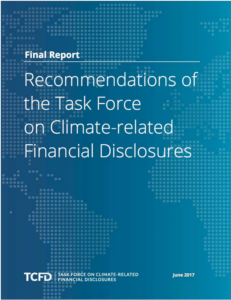
LGPS funds face implementing reporting guidelines from the Task Force on Climate-related Financial Disclosures (TCFD) along with the rest of the pensions industry. Karen Shackleton looks at the key issues involved.
The consultation from the Department for Work and Pensions (DWP) “Taking action on climate risk: improving governance and reporting by occupational pension schemes”, ran through much of last year, reflecting the government’s commitment to prioritising climate action in UK pension funds.
There is no doubt LGPS funds should be giving climate action careful consideration because the clear message from government is that they are looking to mandate TCFD-aligned disclosures across the economy by 2025.
In 2019, only 42% of pension funds who received letters from the minister for pensions were making TCFD-aligned disclosures or planned to do so in the next 12 months.
In November 2020 the government published a roadmap for implementing changes around climate action and earlier this year the Pensions Schemes Bill 2021 was passed through parliament (now awaiting Royal Assent). This Bill requires trustees of larger corporate pension funds to publish TCFD reports by 2022; LGPS funds are likely to be asked to follow suit by 2023. What does this mean in practice for an LGPS committee?
TCFD reporting requires pension funds to consider their approach to climate action from four different perspectives:
- Governance;
- Strategy;
- Risk management;
- Metrics and targets.
Governance

Pensions committees need to outline how they provide oversight of climate-related risks and opportunities, and how they assess and manage these over time.
This may initially involve holding a workshop on investment beliefs, agreeing a set of priorities and articulating a statement on the fund’s climate strategy which can be reviewed, say, every three years.
A scheme’s responsible investment and, or, ESG policy is important and should be reviewed by the committee on a regular (eg. annual) basis. Some funds commit to an annual manager day dedicated to climate assessment, giving them an opportunity to challenge those managing the underlying assets of the pension fund. Questions raised at these reviews could be included in the TCFD report.
LGPS pools have a role to play, since they are likely to have their own TCFD report: their governance statement on climate action could also be included in the scheme-specific TCFD report. Pensions committees may then like to commit to meeting with pool representatives, to challenge and ask questions, whenever the pool’s TCFD report is updated.
Strategy
The pensions committee will need to consider the climate-related risks and opportunities over the short, medium and long term, the impact of these on the business, strategy and financial planning, and the resilience of that strategy under different climate-related scenarios.
Many LGPS schemes will already have climate risk on their risk register and these entries can be included in the TCFD report as evidence of the way in which climate risks are monitored by the fund. Where schemes have met to discuss investment beliefs, it can be useful to set out the investment thesis underpinning these beliefs as evidence of how the fund is embedding risks and opportunities into the asset portfolio.
Some pools have already undertaken scenario analyses for their member funds—this is one of the TCFD recommendations.
However, the DWP has already acknowledged that scenario analysis is one of the more challenging aspects of TCFD reporting. They observe that funds will be expected to do this “insofar as they are able”.
Risk management
Funds need to outline their processes for identifying, assessing and managing climate-related risks, and they are expected to explain how processes are integrated into the organisation’s overall risk management.
As previously mentioned, where risk registers refer to climate risk, these can serve as evidence on this point. References to risk analysis by the underlying asset managers are also relevant, provided funds can demonstrate how they oversee, monitor and challenge any climate risk reports received. This may be the right section to mention engagement partners such as LAPFF.
Metrics and targets
LGPS funds are expected to disclose the metrics used to assess climate-related risks and opportunities, as well as Scope 1, 2 and (if appropriate) Scope 3 greenhouse gas emissions. They must outline targets being used to manage risks and opportunities going forward.
Most funds should now receive carbon risk metrics from their underlying asset managers and/or their pool which should be listed in this section.
Some funds have gone further and begun to map their entire fund against the Sustainable Development Goals. This too is a useful metric. Some custodians may be able to provide supporting data which can feed into this section.
As it stands, Scope 3 data is still limited and wider climate metrics in private assets remain a challenge. Funds should expect to be on a journey towards a more comprehensive set of metrics, rather than expecting to be able to report fully on Day 1.
There are already some useful TCFD report onlines for LGPS funds to which schemes can refer when embarking on this for the first time. The important point to make is that now is the time to begin work, because it will take time and resources to deliver a comprehensive report for publication.
Karen Shackleton is a director and founder of Pensions for Purpose and a senior adviser at MJ Hudson.
FREE monthly newsletters
Subscribe to Room151 Newsletters
Room151 Linkedin Community
Join here
Monthly Online Treasury Briefing
Sign up here with a .gov.uk email address
Room151 Webinars
Visit the Room151 channel












